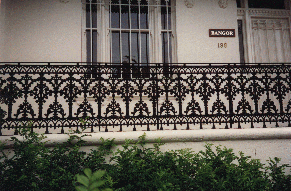Paint rollers for frieze patterns

This article provides an introduction to the classification of frieze patterns by reducing the problem to studying the symmetries of a cylinder. It will be an advantage if you have never met frieze groups but in any case pause now and think about all the symmetries of a cylinder that you can visualise.
It is intuitively obvious that the cylinder can be used as a paint roller so that if a pattern is embossed on it, the pattern can be transferred to paper by repeating it over and over again in a strip with each revolution of the cylinder. Conversely, given a frieze pattern on a piece of paper one can wrap the paper around a cylinder of a suitable radius in such a way that the pattern is produced once and only once on the cylinder. For the purposes of this work we consider symmetries of the cylinder other than those involving rotations about the axis of the cylinder which would correspond to the frieze pattern being copied more than once on the surface of the cylinder. | Image

|
| Frieze patterns and wallpaper patterns occur in the art of many cultures and there is often evidence of exploration of the different possible symmetries. Escher's work was influenced by the frieze and wallpaper patterns he saw on a visit to The Alhambra in Granada, Spain. Some Japanese patterns have to be matched in pairs in one of the NRICH challenges, an NRICH article investigates frieze patterns in car tracks and here is an article by Heather McLeay on frieze groups illustrated by her photos of cast iron railings taken all over the world. | Image

Photo by Heather McLeay |
Image

|
With the footstep pattern on the cylinder shown here the only symmetries are the identity transformation and reflection in a plane containing the axis of the cylinder. Suppose you denote this reflection by $Y$ then $Y^2=I$ and the group is $\{I, Y\}$.The group operation for all the groups referred to in this article is combination of the transformations and for simplicity we simply refer to the groups by giving the set of elements.
|
This pattern involves a reflection $Y$ in a plane through the axis of the cylinder and a reflection $X$ in a plane perpendicular to the axis. The corresponding group must contain the combined transformation $XY$. Can you see that $XY$ and $YX$ both give a rotation about a line perpendicular to the axis of the cylinder? We shall call this rotation $R$. Further checking reveals that $X^2=Y^2=R^2=I$, $XR=RX=Y$ and $YR=RY=X$ so this frieze group is $\{I, X, Y, R\}$. Combining any number of the transformations $X$, $Y$ and $R$ in any order will always reduce to this group of four elements.
There are simpler groups $\{I, X\}$ and $\{I, R\}$ but as soon as we include two of the transformations $X$, $Y$ and $R$ we get all three transformations in the group. While there is only one group of the type $\{I,X\}$ there are many identical in structure (isomorphic) to $\{I, R\}$.
| Image

|
Image

| We have now described five types of group depicted in the first five illustrations here which use a simpler motif than the footprint. The remaining groups involve glide reflections. The group shown in the sixth illustration is the group involving the identity and a glide reflection $G$ where $G^2=I$ so the group is $\{I, G\}$.This is the footprint pattern for someone walking on the beach.
We have already checked what happens when we form any combinations of $X$, $Y$ and $R$ with each other and discovered that they yield only five possible frieze group types.
It remains to check what happens when we combine $G$ with $X$, $Y$ or $R$ and to discover how many additional groups this gives.
First check $XG$. This gives a translation half way around the circumference of the cylinder so it is ruled out as one of the acceptable frieze group types because when printed it would give two translations with one revolution of the cylinder.
|
When we check $YG$ we find $YG=GY$ and the group is shown in the seventh illustration above. This combination also introduces a rotation about a line through the axis of the cylinder and perpendicular to the axis (the same type as $R$ shown in the fourth illustration). The seventh group is $\{I, Y, G, R\}$.
This discussion does not constitute a rigorous proof that there are only seven types of frieze group but when considering the cylinder it becomes intuitively obvious. A complete proof based on the symmetries of a cylinder, much simpler than the usual published proofs, can be given using 3 by 3 matrices in 3-space or using mappings in the complex plane.
In summary the seven frieze groups corresponding to the groups of symmetries of a cylinder with the transformations as defined above are :
(1) $\{I\}$ giving the frieze pattern ppppppppppp
(2) $\{I, X\}$ giving the frieze pattern EEEEEEEEE
(3) $\{I, Y\}$ giving the frieze pattern pqpqpqpqpqp
(4) $\{I, R\}$ giving the frieze pattern pdpdpdpdpdp
(5) $\{I, X, Y, R\}$ giving the frieze pattern HHHHHHHH
(6) $\{I, G\}$ giving the frieze pattern pbpbpbpbpbpbp
(7) $\{I, Y, G, R\}$giving the frieze pattern pqbdpqbdpqbd
